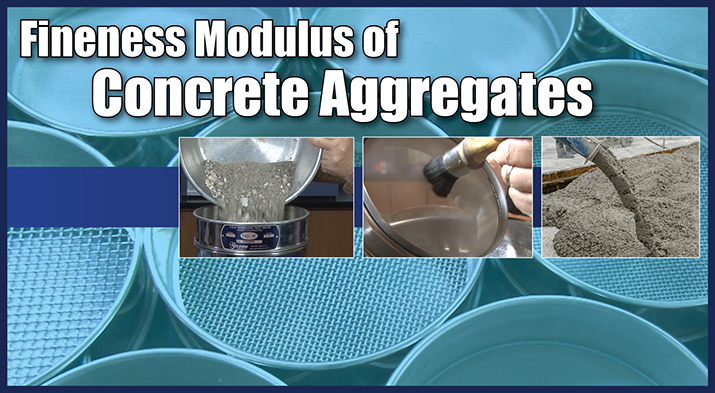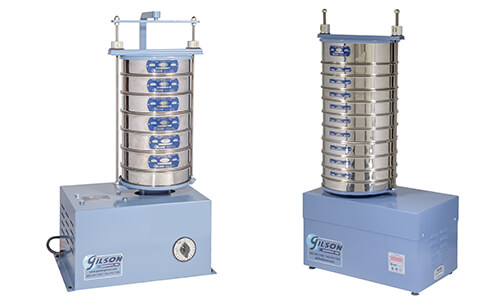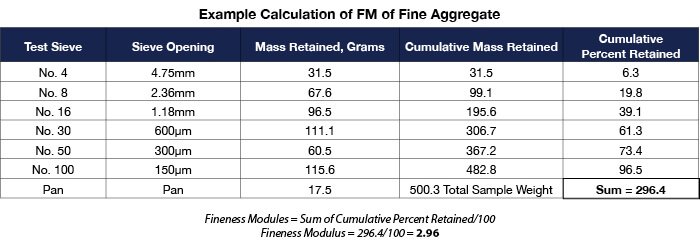
What is Fineness Modulus?
The fineness modulus (FM) of aggregates can be an intimidating term, but it’s just an empirical value that describes the average size of particles in a sample of aggregate. This factor provides a basis to select estimated proportions for concrete mix design, but its real influence is not always understood. Fineness modulus is not a precise value, as it provides a way to estimate the amount of aggregate needed to proportion mix designs.
How is Fineness Modulus Measured?
Fineness modulus is determined using percentages of the size fractions from the sieve analysis and calculated for any designated series of sieve sizes. When designing concrete mixes, the FM of the fine aggregate is required for the effective proportioning of mixes. Changes to the grading of the coarse aggregate portion have less of an effect on overall concrete properties. Aggregate proportioning can be optimized using separate determinations of fine and coarse aggregates and blending techniques to control the FM for a concrete mix.
Origins of the Fineness Modulus Concept
Duff Abrams, an American materials researcher in the early part of the 20th century, was influential in studying concrete properties and characteristics. Along with defining the importance of water/cement ratio and developing the slump test, he defined fineness modulus in 1918 as a way of characterizing concrete aggregates, simplifying the gradation curve, and estimating the correct proportions to use in mix designs. In explaining the premise, he said, “Aggregate of the same fineness modulus will require the same quantity of water to produce a mix of the same consistency and give a concrete of the same strength.”
Calculating Fineness Modulus
The simple procedure to compute FM requires performing an accurate particle size analysis as detailed in ASTM C136, Standard Test Method for Sieve Analysis of Fine and Coarse Aggregates. In addition to the sizes needed for particle sizing, specific to the FM calculations must be included as well. Although manual agitation of the sieves is permitted in the standard, Gilson strongly recommends the use of an appropriate sieve shaker to ensure accuracy, repeatability, and efficiency. After the sieve analysis is performed and separated fractions are weighed on suitable scales or balances, the percentages of the fractions are calculated.

Fineness Modulus of Sand
To calculate the fineness modulus of sand, the sum of the cumulative percentages retained on the following sieves are divided by 100: 150μm (No. 100), 300μm (No. 50), 600-μm (No. 30), 1.18mm (No. 16), 2.36mm (No. 8), and 4.75mm (No. 4) for fine aggregates. If FM for coarse aggregates is desired, then sieves of 9.5mm (3⁄8in.), 19.0mm (3⁄4in), 37.5mm (11⁄2in) can be included. There can be even larger sieves that can be added by continuing the ratio of 2:1 to the previous sieve size. No additional equipment is required to make the determination. The same ASTM E11 test sieves are used in the aggregate tests for particle size analysis. In the example below, cumulative percentages for sizes from 4.75mm to 150µm are used to calculate the fineness modulus for this fine aggregate sample.
Fineness Modulus and Coarse Aggregate Proportions
Once the fineness modulus of the fine aggregate is known, it can be used to select proportions of coarse aggregate. In its standard practice 211.1-91 Selecting Proportions for Normal, Heavyweight, and Mass Concrete, The American Concrete Institute (ACI) includes Table A1.5.3.6 giving the volumes of coarse aggregates for various fineness moduli of fine aggregates. If the maximum size of the coarse aggregate and the fineness modulus of the Fine Aggregate are known, the volume of the dry rodded coarse aggregate can be obtained from this table.
An example provided in the ACI 211 standard states that, "For a fine aggregate having a fineness modulus of 2.8 and a 37.5mm nominal maximum size of coarse aggregate, the table indicates that 0.71m3 of coarse aggregate, on a dry-rodded basis, may be used in each cubic meter of concrete. The required dry mass is, therefore, 0.71 x 1600 = 1,136kg."
How Fineness Modulus Affects Concrete Mixes
In a nutshell, fineness modulus describes the gradation curve as well as the texture and uniformity of the material. A lower FM factor means that the aggregate particles in that sample are finer on average. FM of the fine aggregate fraction is also an important predictor of other characteristics of both plastic and hardened concrete like workability, finish ability, shrinkage, porosity, permeability, strength, and the tendency to crack. A higher FM index indicates coarser aggregate that will produce a “harsh” mix, prone to segregation and difficult to place and finish properly. A low FM indicates finer aggregate that will require additional cement and increase water demand. This will be a mix easier to place and finish, but costlier, with increased potential for early-age cracking.
As with many things, there is a sweet spot that gives optimum results. For most mixes, an FM of fine aggregate between 2.5 and 3.0 yields a concrete that is easy to place, easy to finish, and less likely to crack. ASTM C33 requires the FM of fine aggregate to be between 2.3 and 3.1, and that the FM of the final concrete batch cannot vary from the design mix by more than 0.2. Fine aggregate FM’s in the upper end of the spectrum, closer to 3.0, have been noted to produce concrete with good strength and workability in mixes with high cement contents.
To sum up, fineness modulus (FM) is not only required for complete, workable concrete mix designs, but it is also a tool to use in evaluating aggregate gradations, adjusting proportions, and controlling the properties that characterize completed mixes.
We hope this article has brought some definition and clarity to the concept of fineness modulus of aggregates. For questions about your specific applications, contact the testing experts at Gilson.

















